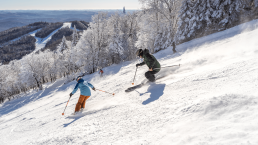Whether you’re skiing or snowboarding, safety is paramount both for you and for others around you.
An essential item in snow equipment is, of course, a helmet to protect your head from impacts. And who says ski helmet also says ski goggles to protect your eyes from the sun’s rays and bad weather. But, how do you choose the right equipment for you? There are several things to consider when shopping for your next ski helmet and googles, such as style, the sport you practise and desired protection you want. Here are some important aspects to consider when looking for new gear.
Helmets: The Differents Safety and Fit Features
Koroyd®
The Koroyd® technology protects against shocks. It is also lighter, more ventilated and absorbs more impact energy than EPS foam. This technology also offers better design flexibility and guarantees more efficient ventilation compared to materials traditionally used in the construction of helmets. The Koroyd® uses cylinders, originally developed from aerospace safety research, to create a structure that behaves differently from these other protective materials, which act more like a spring that stores energy and then releases it. The Koroyd® is a true energy absorber which converts kinetic energy by crushing. This therefore results in better energy absorption in the event of an impact. Whether complete or zonal (see image below), Koroyd® protection is a must in a helmet.
MIPS® (Multi-Directional Impact Protection System)
The famous MIPS®! This is a brain protection system designed to add additional protection to helmets. This system is found inside the helmet, usually between the comfort padding and the EPS foam or Koroyd®. On impact, the MIPS can reduce harmful forces transmitted to the brain. Its core is a low-friction layer which allows the head to move 10-15mm relative to the helmet in all directions, reducing rotational motion transmitted to the brain. Thus, the MIPS® makes your helmet safer and increases protection.

Fit Between the Helmet and Goggles
Of course, it is also very important that your ski helmet and goggles fit perfectly together for comfort, but also to avoid excess humidity and fogging. Almost all SMITH helmets feature what they call Ultimate Integration, which allows the helmet and goggles to integrate well together for optimal comfort and airflow. So the ventilation system of the goggles works with that of the helmet. This is done through holes, either in the front, back or sides of the helmet. This system also makes it possible to better evacuate fog and humidity in the goggles and the helmet.
Ski Goggles: Options for Every Condition
First of all, we would like to tell you that it is strongly advised to try on your next ski goggles with your helmet before buying them. Most goggles fir most ski helmets, but for comfort and fit purposes, it is recommended that you try them on together beforehand. Also, each eyewear is different and fills a different need. For example, some ski goggles have interchangeable lenses. The lens of the goggles is also important because they play a different role depending on the weather. Here are some important features to consider when shopping.
Lens Tint
It is important to have the right lens for the conditions you are in. whether it’s a sunny blue bird day, partly cloudy or a flat light day, every weather conditions have the perfect lens to help you see better when you’re going down the mountain. At SMITH, this technology is called ChromaPop™ and most of their ski goggles have it. Three types of lenses are available.
- Sun: A dark and mirror lens for sunny blue bird days.
- Everyday: A mirror but less dark lens for partly cloudy days or varying conditions.
- Storm: A clear lens for gray and flat light days and for night skiing.
Several brands, including SMITH, also offer a range of photochromic lenses. These change colour depending on the weather, ideal in variable and uncertain ski conditions.

Interchangeable Lenses
More and more ski goggles are now sold with 2 lenses or offer the option of changing lenses to allow interchangeability depending on the weather. Magnet technology is very popular with several brands, such as SMITH with its MAG™ technology. This allows you to change your lens easily using a magnetic latch system so that the lens stays in place and does not fall during the descent or during an impact.

Shape of the Lens
The ski goggle models are multiple, and the shape of the lens varies according to the model. We recommend trying them on before buying to find out which one suits you best depending on your face shape and the style you want. There are therefore cylindrical lenses (curves on a single axis) and spherical lenses (curved on 2 axes). Some ski goggle companies also have even more curved models. This lens exists, among others, at SMITH under the name of 4D MAG™. This allows skiers and snowboarders to have what they call a BirdsEye Vision™, in other words, a greater field of vision when going down the mountain, with the lower portion of the lens which is curved.











